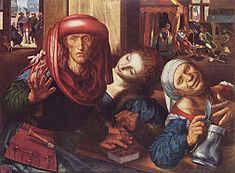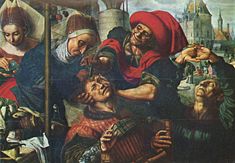
Jan Sanders van Hemessen
Encyclopedia
Jan Sanders van Hemessen (c. 1500 – c. 1566) was a Flemish
Northern Renaissance
painter. He was born in Hemiksem
, then called Hemessen or Heymissen. Following studies in Italy, in 1524 he settled in Antwerp. A mannerist
, his images focused on human failings such as greed and vanity. Like his daughter, Catarina van Hemessen
, he specialised in painted portraits.


His pictures are often religious, while his style helped found the Flemish traditions of genre painting. Hemessen was also a portrait painter, which influenced his daughter to become a Flemish Northern Renaissance painter as well.
The Surgeon of 1555 is an oil painting by Jan Sanders Van Hemessen currently in the Museo del Prado in Madrid, Spain. The scene likely represents a stonecutter at a fair. The surgeon, who is clearly happy that his operations have been successful, painstakingly moves his knife towards the stone, which is already visible. Behind him hang stones which have been successfully cut out of the head of other patients as a sign of his skill. Next to the quack stands a man who is wringing his hands in desperation, clearly going to be the next patient under the scalpel. However, the stone which caused the disease was believed to be in the brain and had to be surgically removed.
Flanders
Flanders is the community of the Flemings but also one of the institutions in Belgium, and a geographical region located in parts of present-day Belgium, France and the Netherlands. "Flanders" can also refer to the northern part of Belgium that contains Brussels, Bruges, Ghent and Antwerp...
Northern Renaissance
Northern Renaissance
The Northern Renaissance is the term used to describe the Renaissance in northern Europe, or more broadly in Europe outside Italy. Before 1450 Italian Renaissance humanism had little influence outside Italy. From the late 15th century the ideas spread around Europe...
painter. He was born in Hemiksem
Hemiksem
Hemiksem is a municipality located in the Belgian province of Antwerp. The municipality only comprises the town of Hemiksem proper. On January 1, 2010 Hemiksem had a total population of 10,166...
, then called Hemessen or Heymissen. Following studies in Italy, in 1524 he settled in Antwerp. A mannerist
Antwerp Mannerism
Antwerp Mannerism is the name given to the style of a largely anonymous group of painters from Antwerp in the beginning of the 16th century. The style bore no direct relation to Renaissance or Italian Mannerism, but the name suggests a peculiarity that was a reaction to the "classic" style of the...
, his images focused on human failings such as greed and vanity. Like his daughter, Catarina van Hemessen
Catarina van Hemessen
Caterina van Hemessen was a Flemish Renaissance painter. She is the earliest female Flemish painter for whom there is verifiable extant work, and is known for a series of small scale female portraits completed between the late 1540s and early 1550s.While not an especially gifted artist, Van...
, he specialised in painted portraits.


Life
Jan Sanders van Hemessen was a Flemish Northern Renaissance painter who was part of the mannerist movement. He was born in Hemessen in the Netherlands but settled in Antwerp in 1524 after studying in Italy. Hemessen specialized in scenes of human character flaws such as vanity and greed.His pictures are often religious, while his style helped found the Flemish traditions of genre painting. Hemessen was also a portrait painter, which influenced his daughter to become a Flemish Northern Renaissance painter as well.
The Surgeon of 1555 is an oil painting by Jan Sanders Van Hemessen currently in the Museo del Prado in Madrid, Spain. The scene likely represents a stonecutter at a fair. The surgeon, who is clearly happy that his operations have been successful, painstakingly moves his knife towards the stone, which is already visible. Behind him hang stones which have been successfully cut out of the head of other patients as a sign of his skill. Next to the quack stands a man who is wringing his hands in desperation, clearly going to be the next patient under the scalpel. However, the stone which caused the disease was believed to be in the brain and had to be surgically removed.
Sources
- Kemperdick, Stephan. The Early Portrait, from the Collection of the Prince of Liechtenstein and the Kunstmuseum Basel. Munich: Prestel, 2006. ISBN 3-7913-3598-7

